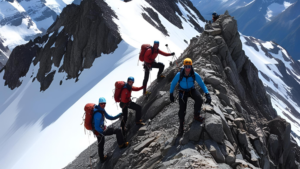Introduction
Mountains have long captured the imagination of adventurers, serving as symbols of challenge, endurance, and personal triumph. From the towering Himalayas to the rugged Rockies, conquering peaks is both a physical and mental feat. Today, in an era where adventure tourism is booming and people seek exhilarating experiences, mountain expeditions have become more accessible and popular.
Whether you are an experienced mountaineer or a beginner looking to embark on your first high-altitude adventure, understanding the intricacies of mountain expeditions is crucial. This guide explores the essential factors to consider, offers practical advice, and shares insights that can help you safely and successfully conquer the peaks.
Understanding Mountain Expeditions
Mountain expeditions involve climbing to significant altitudes, often requiring technical skills, physical endurance, and mental resilience. These expeditions vary in difficulty, from relatively simple treks to technical climbs involving ice axes, ropes, and crampons. Notable peaks such as Mount Everest, Kilimanjaro, and the Matterhorn attract climbers from around the world, each presenting unique challenges and rewards.
The Allure of Mountain Climbing
Why do people choose to climb mountains despite the inherent risks? The reasons are diverse and personal:
- Personal Achievement: Conquering a peak is a test of endurance, discipline, and perseverance.
- Adventure and Exploration: The thrill of the unknown, breathtaking landscapes, and the sense of discovery drive many climbers.
- Physical and Mental Challenge: Climbing pushes the body to its limits while demanding sharp mental focus and resilience.
- Spiritual Connection: Many climbers find solace and a sense of peace in nature’s grandeur.
Key Considerations for a Successful Expedition
1. Choosing the Right Mountain
Selecting an appropriate mountain depends on experience, fitness level, and technical skills. Beginners should start with easier climbs such as Mount Fuji in Japan or Mount Kinabalu in Malaysia before progressing to more challenging peaks like Denali or K2.
2. Training and Physical Preparation
Mountain climbing is physically demanding, requiring strength, endurance, and stamina. Essential training includes:
- Cardiovascular Exercises: Running, cycling, and stair climbing enhance endurance.
- Strength Training: Core strength, leg muscles, and upper body strength are crucial for climbing.
- Altitude Acclimatization: Practicing at higher elevations before the climb reduces the risk of altitude sickness.
- Mental Conditioning: Developing resilience and problem-solving skills is essential for overcoming obstacles during the climb.
3. Essential Gear and Equipment
Equipping yourself with the right gear can mean the difference between success and failure. Some must-have items include:
- Clothing: Layered, moisture-wicking clothing, insulated jackets, and gloves.
- Footwear: High-quality, well-fitted mountaineering boots.
- Technical Equipment: Crampons, ice axes, ropes, harnesses, and helmets for technical climbs.
- Backpack Essentials: Navigation tools (GPS, map, compass), first-aid kit, food, and hydration systems.
4. Understanding Altitude Sickness and Safety Measures
High altitudes pose significant risks, including altitude sickness, frostbite, and hypothermia. Symptoms of altitude sickness include headaches, nausea, and dizziness. Preventative measures include:
- Gradual Acclimatization: Ascend slowly to allow the body to adapt.
- Hydration and Nutrition: Staying hydrated and consuming energy-rich foods helps maintain strength.
- Oxygen and Medication: Carrying supplemental oxygen and medications like acetazolamide can mitigate altitude sickness.
Practical Tips for Mountain Expeditions
1. Start Small and Progress Gradually
Beginners should start with less demanding climbs and gradually build their experience and confidence. Attempting a difficult peak without proper preparation can be dangerous.
2. Join a Guided Expedition
For those new to high-altitude climbing, joining a guided expedition led by experienced mountaineers increases safety and provides valuable learning opportunities.
3. Respect the Environment
Mountains are fragile ecosystems. Practicing responsible mountaineering involves:
- Following Leave No Trace principles.
- Avoiding unnecessary waste and pollution.
- Respecting local cultures and communities.
4. Prepare for the Unexpected
Weather conditions in the mountains can change rapidly. Always be prepared with contingency plans, emergency contacts, and survival strategies.
Real-World Examples of Thrilling Expeditions
- Mount Everest (8,848m) – The ultimate challenge for seasoned climbers, requiring months of preparation and significant resources.
- Kilimanjaro (5,895m) – A popular choice for those looking for a high-altitude challenge without technical climbing.
- Matterhorn (4,478m) – A classic, technically challenging climb in the Alps that attracts experienced mountaineers.
- Denali (6,190m) – North America’s highest peak, known for its extreme weather conditions and demanding routes.
Conclusion
Mountain expeditions are exhilarating experiences that test physical endurance, mental resilience, and survival skills. Whether you aim to climb a small peak or tackle the world’s highest summits, careful preparation, the right gear, and proper training are essential for success.
For those seeking adventure, the mountains offer an unparalleled journey filled with challenges and triumphs. Take the first step by researching, training, and preparing—your next thrilling expedition awaits!
Embrace the adventure, conquer the peaks, and experience the world from breathtaking heights!

